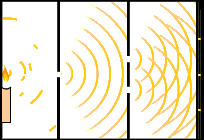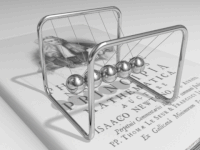Portal:Physics/2010 Selected pictures
| |||
Please do not edit this page directly. Instead, use one of the "Edit" links on the bottom right of the corresponding section. This will ensure that you edit the correct page for your changes to appear on Portal:Physics in the correct week.
January
[edit]The supernova remnant of "Tycho's Supernova", a huge ball of expanding plasma. The blue outer shell arises from X-ray emission by high-speed electrons.
February
[edit]Earth's magnetic field (and the surface magnetic field) is approximately a magnetic dipole, with the magnetic field S pole near the Earth's geographic north pole (see Magnetic North Pole) and the other magnetic field N pole near the Earth's geographic south pole (see Magnetic South Pole). The cause of the field can be explained by dynamo theory. Magnetic fields extend infinitely, though they are weaker further from their source. The Earth's magnetic field, which effectively extends several tens of thousands of kilometres into space, is called the magnetosphere.
March
[edit]
Simulated view of a black hole in front of the Large Magellanic Cloud. The ratio between the black hole Schwarzschild radius and the observer distance to it is 1:9. Of note is the gravitational lensing effect known as an Einstein ring, which produces a set of two fairly bright and large but highly distorted images of the Cloud as compared to its actual angular size.
April
[edit]An illustration of the Double Slit Experiment

May
[edit]An illustration of the Double Slit Experiment

June
[edit]Since the twentieth century, most individual physicists have specialized in either theoretical physics or experimental physics. The Large Haldron Collider is an example of the experimental physics specialization in action. However, theoretical physics can accurately predict expected results of a given experiment, in its appropriate environment.

.
July
[edit]
Newton's cradle, named after Sir Isaac Newton, is a device that demonstrates conservation of momentum and energy via a series of swinging spheres. When one on the end is lifted and released, the resulting force travels through the line and pushes the last one upward.
August
[edit]Newton's cradle, named after Sir Isaac Newton, is a device that demonstrates conservation of momentum and energy via a series of swinging spheres. When one on the end is lifted and released, the resulting force travels through the line and pushes the last one upward.

September
[edit]This is an artist's concept of the Universe's expansion known as inflation. In this image space is represented at each time by the circular sections. This includes hypothetical, and non-observable portions of the Universe. Note on the left the dramatic expansion (not to scale) occurring in the inflationary epoch. At the center is the accelerated expansion. The scheme is decorated with WMAP images on the left, and with the representation of stars at the appropriate level of development.

October
[edit]
.
November
[edit]
Graphene is a one-atom-thick planar sheet of sp2-bonded carbon atoms that are densely packed in a honeycomb crystal lattice. The term Graphene was coined as a combination of graphite and the suffix -ene by Hanns-Peter Boehm, who described single-layer carbon foils in 1962. Graphene is most easily visualized as an atomic-scale chicken wire made of carbon atoms and their bonds.
December
[edit]Albert Einstein (14 March 1879 – 18 April 1955) was a theoretical physicist, philosopher and author who is widely regarded as one of the most influential and best known scientists and intellectuals of all time. A German-Swiss Nobel laureate, Einstein is often regarded as the father of modern physics.[1] He received the 1921 Nobel Prize in Physics "for his services to theoretical physics, and especially for his discovery of the law of the photoelectric effect".[2]
- ^ Zahar, Élie (2001), Poincaré's Philosophy. From Conventionalism to Phenomenology, Carus Publishing Company, p. 41, ISBN 0-8126-9435-X, Chapter 2, p. 41
- ^ The Nobel Prize in Physics 1921, Nobel Foundation, archived from the original on 5 October 2008, retrieved 6 March 2007


